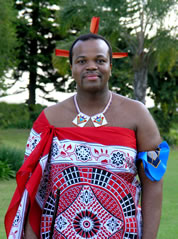Background Swaziland has always been a land of kings and since the building of the nation, a line of kings has led the people. During the 15 th and 16 centuries, Africans of Nguni descent migrated southwards from Central Africa under the leadership of Dlamini III and under th Ngwane III, in the mid 18 century, some of them settled in the area which today is Shiselwini in southern Swaziland. These people, the Nkosi Dlamini, became known as Swazis and today the usage of both names continues. Nkosi means king and Dlamini is the surname of the royal family. The royal line of Dlamini dates back to about 1550. During King Mbandzeni’s reign the British dismantled the Zulu kingdom in 1879 and to secure ongoing independence and avoid land grabbing by South Africa, he made a series of grazing, mining and trade concessions. This attracted unscrupulous agents and opportunists and ironically resulted in loss of territorial independence as concessions were converted to freehold title in the Land Partition of 1907. Until 1894, the kingdom was ruled by a provisional government comprising Boer, British and Swazi. At that point, Swaziland became a protectorate of South Africa under King Bhunu and when Britain won the Anglo Boer War in 1902, that power administered the country as a protectorate until independence in1968.
Swaziland has always been a land of kings and since the building of the nation, a line of kings has led the people. During the 15 th and 16 centuries, Africans of Nguni descent migrated southwards from Central Africa under the leadership of Dlamini III and under th Ngwane III, in the mid 18 century, some of them settled in the area which today is Shiselwini in southern Swaziland. These people, the Nkosi Dlamini, became known as Swazis and today the usage of both names continues. Nkosi means king and Dlamini is the surname of the royal family. The royal line of Dlamini dates back to about 1550. During King Mbandzeni’s reign the British dismantled the Zulu kingdom in 1879 and to secure ongoing independence and avoid land grabbing by South Africa, he made a series of grazing, mining and trade concessions. This attracted unscrupulous agents and opportunists and ironically resulted in loss of territorial independence as concessions were converted to freehold title in the Land Partition of 1907. Until 1894, the kingdom was ruled by a provisional government comprising Boer, British and Swazi. At that point, Swaziland became a protectorate of South Africa under King Bhunu and when Britain won the Anglo Boer War in 1902, that power administered the country as a protectorate until independence in1968.
Queen Gwamile, who was the Regent until Sobhuza II, ascended the throne, was a firm believer in books and education as the foundation for the nation’s growth and after primary school, young Sobhuza, the father of the present King, attended the Lovedale Mission College in the Cape Province of South Africa. He became the world’s longest reigning monarch and throughout his rule, he devoted himself to regaining the lost land, establishing a fund to enable its repurchase. This was a period of stability, rapid economic growth and development.
Following Sobhuza’s death in 1982, Queen Dzeliwe became regent until the young heir, Prince Makhosetive, returned home from Sherborne School in England, and following year in 1986, aged only 18 years, he was installed as King Mswati III. Mswati has established an amended constitution and heads a nation in which ancient traditions and culture work hand in hand with modern technology, economic practice and infrastructure that attract investors from all over the world.
Choosing the King
The heir to the throne is chosen accordingto his mother’s status as a Queen Mother
is selected based on her high rank, by the Royal Council following the king’s death. The King is always a Dlamini and never intermarries so the Queen Mother is never a Dlamini. The king must be her only son and is expected to choose wives from various clans to ensure national unity. The monarchy is a dual one with the balance of power lying with the King - Ngwenyama (or lion) - and the Queen Mother, who is the Ndlovukazi (she elephant). The Royal Council plays a key role in the selection of the heir to the throne. He must be unmarried, and if still a minor, the Queen Mother to the late King assumes the responsibility of Regent until the Crown Prince becomes the Ngweny ama.
